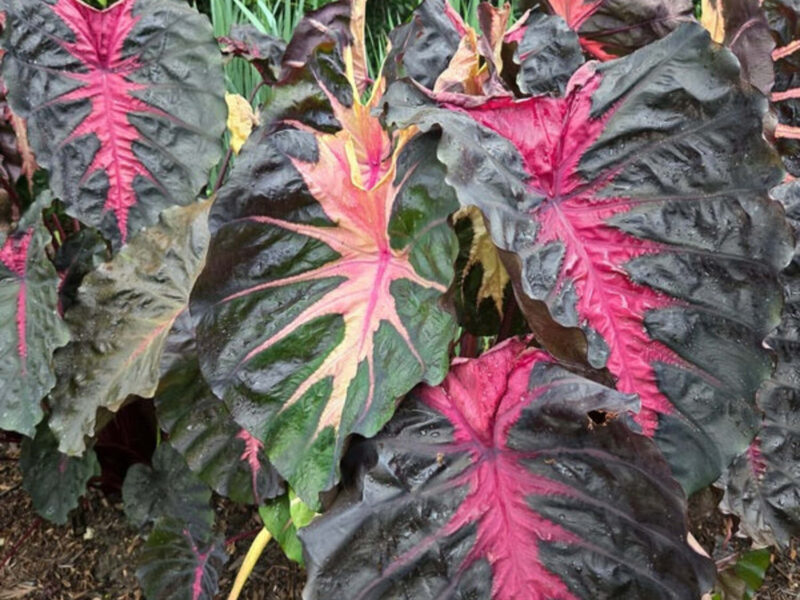

They are often referred to as rhizomes, and it can be a bit confusing, but what’s not confusing is that all of the tubers we plant in our East End gardens are of tropical origin, and therefore, not hardy.
So you might be thinking, why would you want to spend nearly $20 for a tuber that might give you some very nice flowers but then die and rot in the ground as soon as it gets cold in the fall? A wonderful display of several varieties of cannas in a border could set you back hundreds of dollars only to be treated as a disposable annual. For many of us though there is a method to our madness.
First, before we get too deep into tuberland, a trip back to my childhood. In the front of our house along our shared private driveway, was a long landscape bed that was about 3 feet wide and maybe 60 or so feet long. After a number of years of messing with this bed in the late 1950s my father discovered and planted cannas. They grew taller than me and at their peak of growth the flowers appeared in red and yellow in an incredible display that lasted weeks and weeks. The result was a glorious long row of lush green foliage topped by an array of yellow and red sky-reaching flowers.
One of the best parts of tuberland is that if you’re a good gardener, or one willing to learn, your investment in these specialized roots can give you dividends and returns for years and years without any additional investment. How is this possible with a frost/freeze tender plant?
The secret is that while these plants are cold tender and will shrivel and die when frosted or frozen, the tubers themselves can be dug, stored indoors and replanted the following year. And while each of these plants is very, very different in their flowers, performance and habit, each of them had this great trait of being storable and replantable. Their differences make winter storage different but easily learned.
Simply put, tubers are specialized roots, and the one you are probably most familiar with is the potato. But as you’ll see, tubers can be in various shapes and sizes, and from one plant variety to the next, the tubers look different and to some degree they are treated differently.
The largest tuber we deal with in the garden is the canna tuber. These are large and fleshy tubers that can be an inch or more in diameter and often a half a foot long. They also have smaller fine roots attached to them (nonreproductive) and the tuber in its dormant stage has several eyes on it or small sprouts. We grade these canna tubers by the number of “eyes” it has. For our purposes we like to see three to five eyes on a canna tuber as these will be the ones that send up the greatest number of shoots and thus flower stalks. You’ll find these tubers for sale online and in garden centers (later in the spring) packed in wood shavings or sawdust.
Canna tubers get planted 4 to 6 inches deep and always horizontally. If there are more eyes on one side of the tuber then plant with those eyes toward the sky. The rest will still develop, just a bit later. Canna tubers get planted when the soil is warm as they’ll rot in cold and wet soil. There’s little else to do after planting other than applying an organic fertilizer to the ground around the plants a few times during the summer. There are dwarf varieties, and the taller types really don’t need staking.
Cannas are available in a range of colors from red to pink and yellow, but some varieties, like Tropicana, are grown not only for their scarlet-orange flowers but the foliage, which is maroon to pink with darker stripes in the foliage. There are several variations of Tropicana so see which one tickles your fancy. Like all the cannas, they prefer sun but may tolerate very light shade.
In the fall the canna plants are dug, the stems cut down to a few inches then allowed to dry (cure) before being stored in sand, wood shavings or sawdust then kept in a cool and dry spot out of sunlight at lower than 60 degrees but over 40 degrees. If stored wet, damp or if they don’t get enough air circulation while in storage they will rot.
The tubers will need a visual check during the winter, and in the late spring they are taken out of storage and divided so that each stored tuber has only three or four eyes. You’ll find that many can be divided and this is the dividend side of your efforts.
Dahlias (not shorter bedding dahlias) are very different plants. They still grow from tubers but look diametrically different from cannas. Dahlia tubers may be shorter and thinner but are stored and harvested in the same way as the cannas. Some gardeners like to plant established dahlia plants and to do this you plant them indoors in large pots (like gallon and 2-gallon nursery pots). This only works if you have a bright sunny spot to warm the pots as the plants develop and in the garden this plant also prefers a sunny disposition with warm soil.
Unlike the cannas, the dahlias have several types of flowers in a wide range of colors and heights not to be confused with the annual bedding types of dahlias. To get large exhibition-size flowers on your plants watch for the emergence of the buds, which usually occur in groups of three. Pinch or roll off the two side buds as soon as they are noticeable and allow the center bud to grow.
Dahlias can be tall enough to require discrete staking, and this is particularly true if your goal is to grow larger flowers. Like the cannas they are not frost or freeze tolerant and waiting too long to dig them in the fall will result in rotted tubers. And like the cannas, once they begin to emerge above the ground, in pots or outdoors, fertilize a few times during the growing season.
Caladiums are yet another tuberous plant and in southern areas like Florida and the Carolinas they are left in the ground and treated like perennials. We can’t do that up here but the tubers can be planted in ornamental beds toward the front (they are much shorter than cannas and dahlias) where they are grown for their range of foliage colors as opposed to flowers. They can also be planted in pots, containers and larger handing baskets.
Before a freeze or frost they need to be dug, dried, the foliage removed, and the dried tubers stored in the same manner as the tubers discussed above. Cannas and dahlias are fairly insect resistant, but whitefly seems to love the foliage of caladiums so keep an eye out.
The last two plants on our tuber list are alocasia and colocasia. Alocasia is the plant we usually refer to as elephant ears since they have very large, green leaves similar in shape to the elephant ears. There are several varieties with color variations but the most common is green. They thrive in our warm and humid summers but will languish if planted or if they go outside too early. For this reason they are often started indoors then brought outdoors later in May.
These plants will grow in bright light or partial shade but in full sun the foliage will scorch. These are water-loving plants so the soil should be kept on the moist side but not wet. The larger the plants get the more they’ll need fertilizer and a balanced, liquid organic will suit them well two or three times during the summer.
Aside from the usual green species you can find Alocasia zebrind, which has striped foliage, and Black Velvet, which has dark green foliage with white veins (but it’s a dwarf at only 18 inches). Only prune the plants to remove dead or dying foliage. Use sharp scissors but clean the blades with an alcohol wipe as you move from stem to stem.
Alocasia tubers should be dug or unpotted long before frosts or freezing and stored as the tubers noted above or in dry, peat-based potting soil not adding any moisture. Restart the plants indoors in late February or March so they’re a good size when brought outside. They will rarely get large enough if planted directly outdoors.
Colocasia grows from a rhizome that is a specialized tuber. Both the colocasia and alocasia tubers look very different from the canna and dahlia tubers as they are rounded instead of oblong. It’s grown as both a houseplant and a tender ornamental, but if you are planning on keeping them outdoors they will need to be started indoors in February or March then moved outdoors in the warmer months. They can be left in the pots when moved indoors in the fall for storage and dormancy but should be repotted before they are restarted. Both of these plants can also be grown as dramatic houseplants but will need bright light, though not necessarily direct sunlight.
Calocasia is a valuable food staple in many tropical areas where it’s known as the taro root. The tuber is ground and dried and used as a flour and is used in Asian cooking. However, the tuber, uncooked, is very poisonous, so keep it away from pets and children when it’s out of the ground.
Plant Delights nursery sells about 15 ornamental varieties each in the $30 range, but look at their online catalog (plantdelights.com) to see the diversity and range of colors especially “Redemption,” which could be a stunner in the summer garden. Just keep in mind that it needs to be started soon indoors in a pot.
So that’s this week’s trip through tuber diversity. It’s amazing to see so many different colors, shapes and habits of these ornamental tubers and they may very well have a place on your patio or in your garden. Take the challenge. See how well you do in holding any of them over from one year to the next. And of course, keep growing.
 More Posts from Andrew Messinger
More Posts from Andrew Messinger